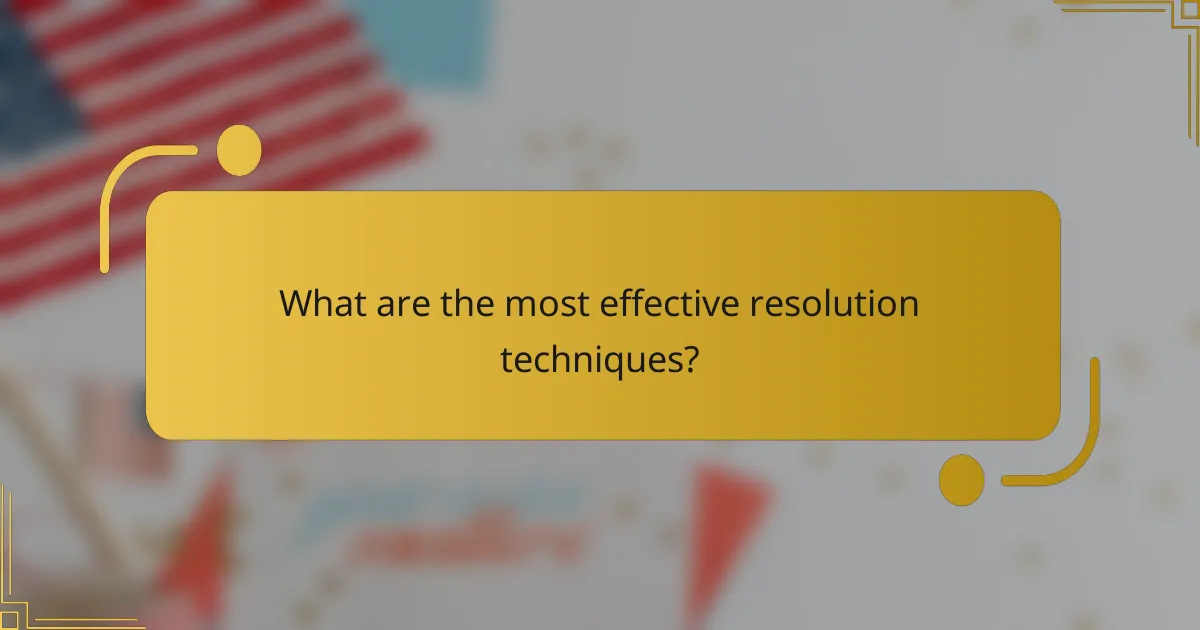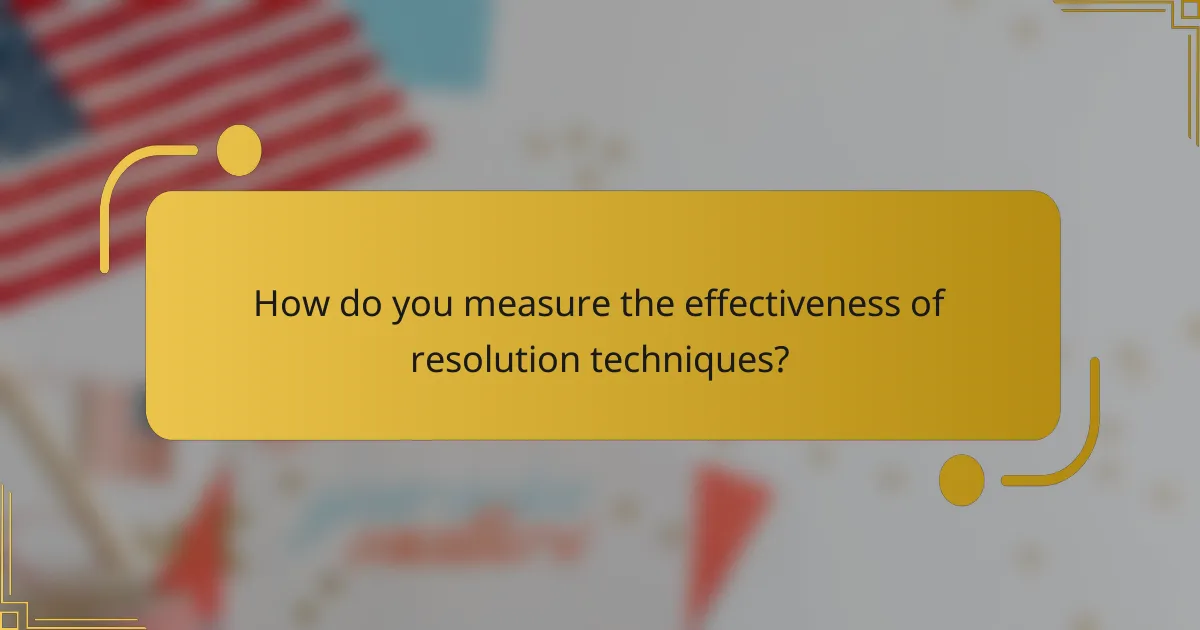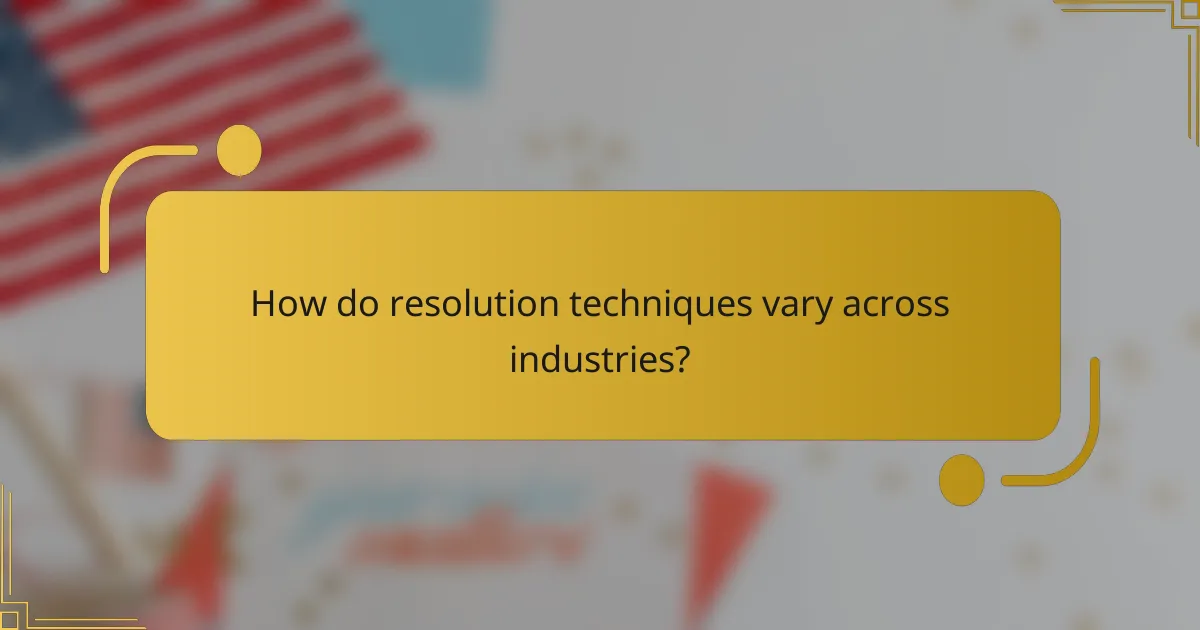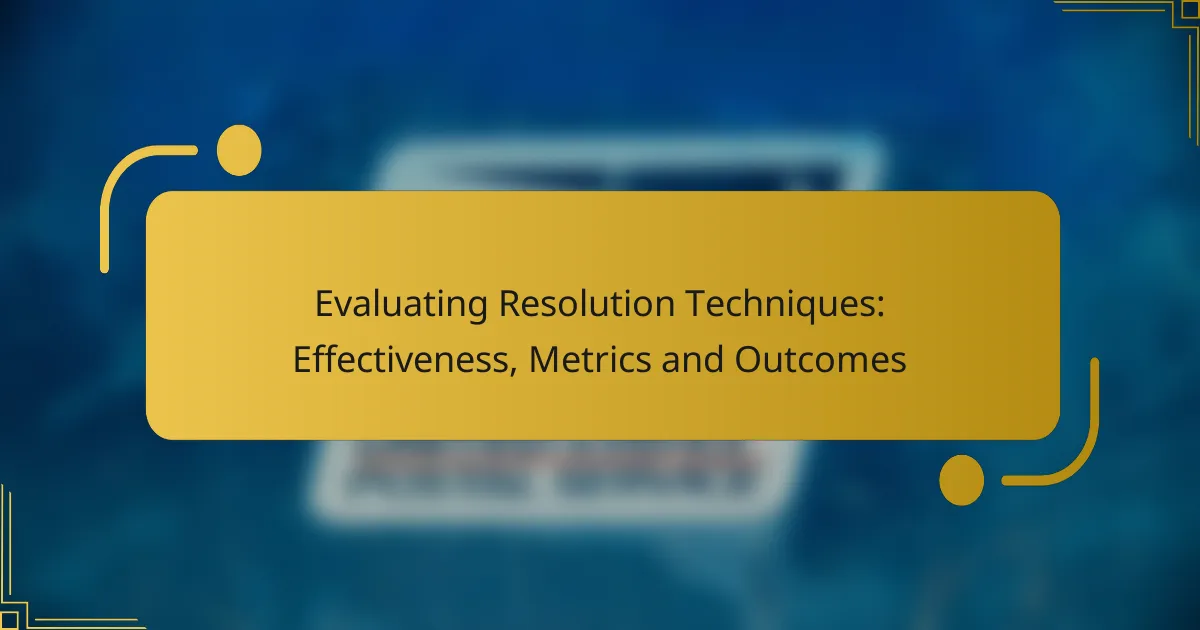Evaluating resolution techniques is crucial for understanding their effectiveness in addressing various issues. By analyzing specific metrics such as customer satisfaction and resolution time, organizations can gain insights into the performance and outcomes of these techniques. Ultimately, effective resolution strategies not only enhance customer satisfaction but also contribute to improved organizational performance and collaboration.

What are the most effective resolution techniques?
The most effective resolution techniques include collaborative problem-solving, root cause analysis, conflict resolution frameworks, data-driven decision making, and negotiation strategies. Each technique offers unique advantages and can be applied based on the specific context and nature of the issue at hand.
Collaborative problem-solving
Collaborative problem-solving involves bringing together stakeholders to work jointly on a solution. This technique fosters open communication, encourages diverse perspectives, and builds consensus, making it particularly effective in team settings or community disputes.
To implement this approach, establish a safe environment for discussion, define the problem clearly, and guide participants through brainstorming and evaluating potential solutions. Avoid dominance by any single participant to ensure all voices are heard.
Root cause analysis
Root cause analysis (RCA) aims to identify the fundamental cause of a problem rather than just addressing its symptoms. This technique helps prevent recurrence by focusing on underlying issues.
Common methods include the “5 Whys” technique and fishbone diagrams. When conducting RCA, gather data, involve relevant stakeholders, and document findings to ensure transparency and accountability in the resolution process.
Conflict resolution frameworks
Conflict resolution frameworks provide structured approaches to resolving disputes. These frameworks often include steps such as identifying the conflict, understanding perspectives, and negotiating solutions.
Popular frameworks, like the Thomas-Kilmann Conflict Mode Instrument, help individuals understand their conflict-handling styles. Applying these frameworks can lead to more effective and sustainable resolutions by ensuring all parties feel heard and respected.
Data-driven decision making
Data-driven decision making utilizes quantitative and qualitative data to inform resolution techniques. This approach enhances objectivity and can lead to more effective outcomes by relying on evidence rather than assumptions.
To implement this technique, collect relevant data, analyze trends, and use insights to guide decisions. Ensure that data sources are reliable and that stakeholders understand the implications of the findings to foster buy-in.
Negotiation strategies
Negotiation strategies are essential for reaching agreements in conflicts. Effective negotiation involves preparation, clear communication, and the ability to find mutually beneficial solutions.
Key strategies include understanding interests versus positions, exploring options for mutual gain, and maintaining a collaborative mindset. Practicing active listening and empathy can significantly enhance negotiation outcomes, leading to more satisfactory resolutions for all parties involved.

How do you measure the effectiveness of resolution techniques?
Measuring the effectiveness of resolution techniques involves evaluating various metrics that indicate how well issues are resolved. Key performance indicators, customer satisfaction surveys, resolution time metrics, and follow-up assessments provide a comprehensive view of performance and outcomes.
Key performance indicators (KPIs)
Key performance indicators are quantifiable measures that help assess the success of resolution techniques. Common KPIs include first contact resolution rate, escalation rate, and average handling time. These metrics allow organizations to track performance trends and identify areas for improvement.
For example, a high first contact resolution rate suggests that issues are being effectively addressed during the initial interaction, which can enhance customer satisfaction and reduce operational costs. Regularly reviewing these KPIs can help teams adjust their strategies to improve overall effectiveness.
Customer satisfaction surveys
Customer satisfaction surveys are vital for gauging how well resolution techniques meet client expectations. These surveys often include questions about the resolution process, the representative’s performance, and overall satisfaction with the outcome. Collecting feedback directly from customers provides insights into their experiences and perceptions.
To maximize the effectiveness of these surveys, consider using a mix of quantitative ratings and qualitative feedback. This approach allows for a deeper understanding of customer sentiments and can highlight specific areas needing attention, such as communication or follow-up practices.
Resolution time metrics
Resolution time metrics track how long it takes to resolve issues from the moment they are reported. This includes measuring average resolution time and time to first response. Shorter resolution times generally indicate more effective techniques and can lead to higher customer satisfaction.
Organizations should aim for resolution times that align with industry standards. For example, resolving issues within a few hours or a day is often expected in many sectors. Monitoring these metrics helps identify bottlenecks in the resolution process and allows for timely adjustments.
Follow-up assessments
Follow-up assessments involve checking in with customers after their issues have been resolved to evaluate their satisfaction and gather additional feedback. This process can uncover any lingering concerns and provide opportunities for further improvement. Effective follow-ups can reinforce positive experiences and build long-term customer loyalty.
Implementing a structured follow-up process, such as a phone call or an email survey, can enhance the effectiveness of resolution techniques. Aim to conduct follow-ups within a few days of resolution to ensure feedback is fresh and relevant, allowing for prompt action on any identified issues.

What are the outcomes of effective resolution techniques?
Effective resolution techniques lead to significant outcomes that enhance both customer satisfaction and organizational performance. These outcomes include increased loyalty from customers, improved collaboration among teams, a stronger organizational reputation, and a reduction in recurring conflicts.
Increased customer loyalty
When resolution techniques are effectively implemented, customers feel valued and understood, which fosters loyalty. A positive resolution experience can turn a dissatisfied customer into a repeat buyer, often leading to long-term relationships.
To cultivate loyalty, organizations should focus on personalized communication and timely follow-ups after resolving issues. Simple gestures, like sending a thank-you note or offering a small discount, can reinforce customer appreciation.
Improved team collaboration
Effective resolution techniques encourage better communication and collaboration among team members. When conflicts are resolved efficiently, teams can focus on their core tasks rather than getting bogged down by unresolved issues.
To enhance collaboration, organizations should promote open dialogue and regular feedback sessions. Tools like collaborative software can facilitate this process, allowing team members to share insights and strategies for resolving conflicts.
Enhanced organizational reputation
A strong reputation is built on how well an organization handles conflicts and resolutions. Effective techniques not only resolve issues but also demonstrate a commitment to customer care, which can enhance public perception.
Organizations should actively seek feedback on their resolution processes and showcase positive outcomes through testimonials or case studies. This transparency can significantly boost credibility and attract new customers.
Reduced conflict recurrence
Implementing effective resolution techniques can lead to a noticeable decrease in the recurrence of conflicts. By identifying root causes and addressing them, organizations can prevent similar issues from arising in the future.
To minimize conflict recurrence, it’s essential to analyze past conflicts and develop strategies to address underlying problems. Regular training for staff on conflict resolution can also equip them with the skills needed to handle future issues proactively.

What criteria should be considered when evaluating resolution techniques?
When evaluating resolution techniques, key criteria include contextual relevance, stakeholder involvement, and resource availability. These factors help determine the effectiveness and suitability of a resolution method for specific situations.
Contextual relevance
Contextual relevance refers to how well a resolution technique fits the specific circumstances of a situation. Consider the nature of the issue, the environment in which it occurs, and the cultural or organizational norms that may influence outcomes. For example, a conflict resolution approach that works well in a corporate setting may not be effective in a community dispute.
To assess contextual relevance, analyze past cases and outcomes related to similar issues. This can provide insights into which techniques have been successful under comparable conditions, helping to inform your decision-making process.
Stakeholder involvement
Stakeholder involvement is crucial for the success of any resolution technique. Engaging relevant parties ensures that their perspectives and needs are considered, which can lead to more sustainable solutions. Identify key stakeholders early in the process and involve them in discussions to gather input and foster collaboration.
Effective stakeholder involvement can be achieved through regular communication and feedback loops. Techniques such as surveys or focus groups can help gauge stakeholder sentiments and preferences, ultimately leading to a more inclusive resolution process.
Resource availability
Resource availability encompasses the financial, human, and technological resources necessary to implement a resolution technique effectively. Assessing what resources are at your disposal will help determine which techniques are feasible. For instance, a complex mediation process may require trained facilitators and significant time investment, while simpler techniques might be more manageable with limited resources.
To optimize resource allocation, create a checklist of required resources for each potential resolution technique. This can help identify gaps and ensure that you are prepared to implement the chosen approach without overextending your capabilities.

How do resolution techniques vary across industries?
Resolution techniques differ significantly across industries, influenced by specific operational needs and regulatory requirements. For example, the healthcare sector prioritizes patient safety and compliance, while the tech industry focuses on rapid problem-solving and customer satisfaction.
Healthcare Industry
In healthcare, resolution techniques often involve strict protocols to ensure patient safety and regulatory compliance. Techniques such as root cause analysis (RCA) are commonly used to investigate incidents and prevent future occurrences. This method emphasizes thorough documentation and adherence to standards set by organizations like the Joint Commission.
Healthcare professionals must also consider the emotional aspects of resolution, as patient interactions can be sensitive. Effective communication and empathy are crucial when addressing patient concerns or complaints.
Technology Sector
The technology sector employs agile resolution techniques that prioritize speed and efficiency. Methods like the Agile framework encourage rapid iterations and feedback loops, allowing teams to quickly address issues as they arise. This approach often leads to continuous improvement and higher customer satisfaction.
Additionally, tech companies frequently utilize metrics such as mean time to resolution (MTTR) to evaluate the effectiveness of their techniques. Keeping MTTR low is essential for maintaining user trust and operational efficiency.
Manufacturing Industry
Manufacturing resolution techniques focus on minimizing downtime and optimizing production processes. Techniques such as Six Sigma and Lean Manufacturing aim to identify and eliminate waste, enhancing overall efficiency. These methodologies rely heavily on data analysis and process mapping to drive improvements.
In this sector, it is vital to implement preventive measures and conduct regular training to ensure that all employees understand the resolution techniques in place. This proactive approach can significantly reduce operational disruptions.
Financial Services
In financial services, resolution techniques must comply with stringent regulations and protect sensitive customer information. Techniques such as dispute resolution processes are critical for addressing customer complaints and ensuring compliance with laws like the Fair Credit Reporting Act (FCRA).
Financial institutions often use metrics like customer satisfaction scores and resolution timeframes to assess the effectiveness of their techniques. A focus on transparency and clear communication can help build trust with clients and enhance overall service quality.



